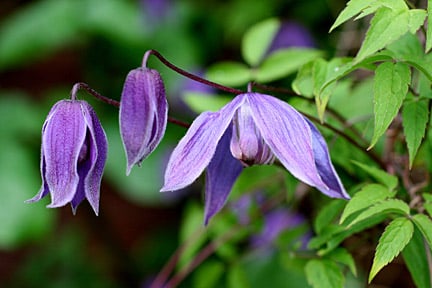
Quick facts
Suitable for - Clematis flowering in spring on shoots produced the previous season
Timing - Immediately after flowering in mid- to late spring
Difficulty - Moderately easy
Suitable for...
There are numerous clematis species, hybrids and cultivars, but for pruning purposes they are split into three distinct pruning groups based on the time of flowering and the age of the flowering wood.
Clematis in pruning group one flower early in the year on shoots produced in the previous summer.
Examples of clematis in pruning group one include:
Clematis alpina AGM
C. alpina 'Pamela Jackman'
C. armandii
C. × cartmanii 'Avalanche'
C. × cartmanii 'White Abundance'
C. cirrhosa
C. cirrhosa var. balearica
C. cirrhosa 'Freckles'
C. cirrhosa 'Wisley Cream' AGM
C. 'White Columbine' AGM
C. 'Constance' AGM
C. 'Frances Rivis' AGM
C. macropetala
C. macropetala 'Blue Bird'
C. 'Markham's Pink' AGM
C. montana
C. 'Rosy O'Grady'
C. 'Ruby'
When to prune clematis in group one
For this group no regular pruning is required, but if necessary, prune immediately after flowering in mid- to late spring when the danger of frost has passed.
How to prune clematis in group one
Initial pruning and training
If young clematis plants are left unpruned they often produce very long single stems with the flowers produced only at the very top.
Unless the plant already has three or four healthy stems growing from the base, all newly planted clematis should be pruned back hard the first spring after planting. Cut back to just above a strong pair of leaf about 30cm (12in) above soil level. This will encourage multiple stems which can be trained to supports to give good coverage.
During the spring and summer, tie in new growth, spacing stems evenly on the support.
Pruning established plants
- Trim overlong branches and prune back dead or winter-damaged shoots to a pair of healthy buds
- Vigorous clematis, such as C. montana, can be simply sheared over after flowering to keep them tidy
- Old congested plants can be thinned but it is usually easier to renovate
- To renovate, cut all stems back almost to the base, just after flowering. Apply a general fertiliser, and water in dry spells. Response is generally good. Leave at least three years before pruning hard again
- C. armandii does not usually respond well to renovation and pruning of should be limited to restricting them to the space available and removing, in spring, any leaves damaged by wind scorch


